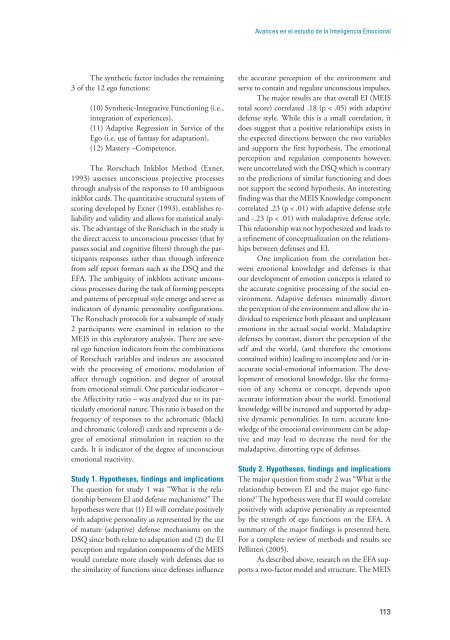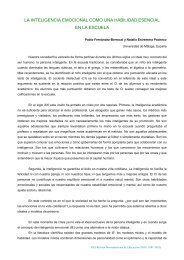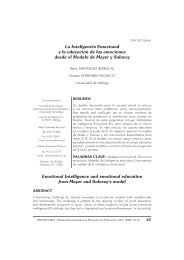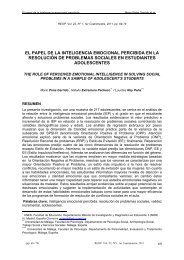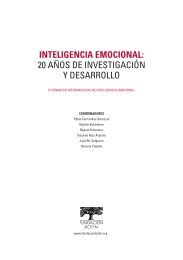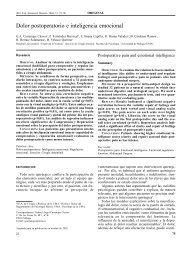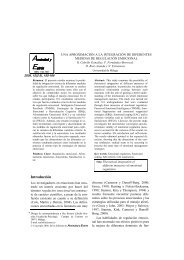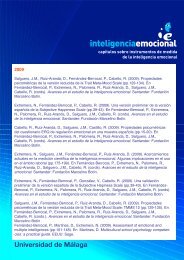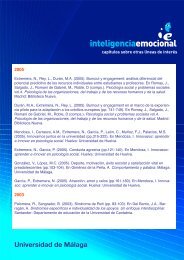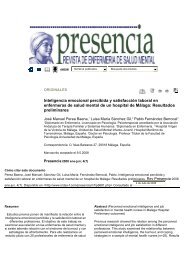Avances en el estudio de la Inteligencia Emocional
Avances en el estudio de la Inteligencia Emocional
Avances en el estudio de la Inteligencia Emocional
You also want an ePaper? Increase the reach of your titles
YUMPU automatically turns print PDFs into web optimized ePapers that Google loves.
<strong>Avances</strong> <strong>en</strong> <strong>el</strong> <strong>estudio</strong> <strong>de</strong> <strong>la</strong> Int<strong>el</strong>ig<strong>en</strong>cia <strong>Emocional</strong><br />
The synthetic factor inclu<strong>de</strong>s the remaining<br />
3 of the 12 ego functions:<br />
(10) Synthetic-Integrative Functioning (i.e.,<br />
integration of experi<strong>en</strong>ces),<br />
(11) Adaptive Regression in Service of the<br />
Ego (i.e. use of fantasy for adaptation),<br />
(12) Mastery –Compet<strong>en</strong>ce.<br />
The Rorschach Inkblot Method (Exner,<br />
1993) assesses unconscious projective processes<br />
through analysis of the responses to 10 ambiguous<br />
inkblot cards. The quantitative structural system of<br />
scoring <strong>de</strong>v<strong>el</strong>oped by Exner (1993), establishes r<strong>el</strong>iability<br />
and validity and allows for statistical analysis.<br />
The advantage of the Rorschach in the study is<br />
the direct access to unconscious processes (that by<br />
passes social and cognitive filters) through the participants<br />
responses rather than through infer<strong>en</strong>ce<br />
from s<strong>el</strong>f report formats such as the DSQ and the<br />
EFA. The ambiguity of inkblots activate unconscious<br />
processes during the task of forming percepts<br />
and patterns of perceptual style emerge and serve as<br />
indicators of dynamic personality configurations.<br />
The Rorschach protocols for a subsample of study<br />
2 participants were examined in r<strong>el</strong>ation to the<br />
MEIS in this exploratory analysis. There are several<br />
ego function indicators from the combinations<br />
of Rorschach variables and in<strong>de</strong>xes are associated<br />
with the processing of emotions, modu<strong>la</strong>tion of<br />
affect through cognition, and <strong>de</strong>gree of arousal<br />
from emotional stimuli. One particu<strong>la</strong>r indicator –<br />
the Affectivity ratio – was analyzed due to its particu<strong>la</strong>rly<br />
emotional nature. This ratio is based on the<br />
frequ<strong>en</strong>cy of responses to the achromatic (b<strong>la</strong>ck)<br />
and chromatic (colored) cards and repres<strong>en</strong>ts a <strong>de</strong>gree<br />
of emotional stimu<strong>la</strong>tion in reaction to the<br />
cards. It is indicator of the <strong>de</strong>gree of unconscious<br />
emotional reactivity.<br />
Study 1. Hypotheses, findings and implications<br />
The question for study 1 was “What is the r<strong>el</strong>ationship<br />
betwe<strong>en</strong> EI and <strong>de</strong>f<strong>en</strong>se mechanisms?” The<br />
hypotheses were that (1) EI will corr<strong>el</strong>ate positiv<strong>el</strong>y<br />
with adaptive personality as repres<strong>en</strong>ted by the use<br />
of mature (adaptive) <strong>de</strong>f<strong>en</strong>se mechanisms on the<br />
DSQ since both r<strong>el</strong>ate to adaptation and (2) the EI<br />
perception and regu<strong>la</strong>tion compon<strong>en</strong>ts of the MEIS<br />
would corr<strong>el</strong>ate more clos<strong>el</strong>y with <strong>de</strong>f<strong>en</strong>ses due to<br />
the simi<strong>la</strong>rity of functions since <strong>de</strong>f<strong>en</strong>ses influ<strong>en</strong>ce<br />
the accurate perception of the <strong>en</strong>vironm<strong>en</strong>t and<br />
serve to contain and regu<strong>la</strong>te unconscious impulses.<br />
The major results are that overall EI (MEIS<br />
total score) corr<strong>el</strong>ated .18 (p < .05) with adaptive<br />
<strong>de</strong>f<strong>en</strong>se style. While this is a small corr<strong>el</strong>ation, it<br />
does suggest that a positive r<strong>el</strong>ationships exists in<br />
the expected directions betwe<strong>en</strong> the two variables<br />
and supports the first hypothesis. The emotional<br />
perception and regu<strong>la</strong>tion compon<strong>en</strong>ts however,<br />
were uncorr<strong>el</strong>ated with the DSQ which is contrary<br />
to the predictions of simi<strong>la</strong>r functioning and does<br />
not support the second hypothesis. An interesting<br />
finding was that the MEIS Knowledge compon<strong>en</strong>t<br />
corr<strong>el</strong>ated .23 (p < .01) with adaptive <strong>de</strong>f<strong>en</strong>se style<br />
and -.23 (p < .01) with ma<strong>la</strong>daptive <strong>de</strong>f<strong>en</strong>se style.<br />
This r<strong>el</strong>ationship was not hypothesized and leads to<br />
a refinem<strong>en</strong>t of conceptualization on the r<strong>el</strong>ationships<br />
betwe<strong>en</strong> <strong>de</strong>f<strong>en</strong>ses and EI.<br />
One implication from the corr<strong>el</strong>ation betwe<strong>en</strong><br />
emotional knowledge and <strong>de</strong>f<strong>en</strong>ses is that<br />
our <strong>de</strong>v<strong>el</strong>opm<strong>en</strong>t of emotion concepts is r<strong>el</strong>ated to<br />
the accurate cognitive processing of the social <strong>en</strong>vironm<strong>en</strong>t.<br />
Adaptive <strong>de</strong>f<strong>en</strong>ses minimally distort<br />
the perception of the <strong>en</strong>vironm<strong>en</strong>t and allow the individual<br />
to experi<strong>en</strong>ce both pleasant and unpleasant<br />
emotions in the actual social world. Ma<strong>la</strong>daptive<br />
<strong>de</strong>f<strong>en</strong>ses by contrast, distort the perception of the<br />
s<strong>el</strong>f and the world, (and therefore the emotions<br />
contained within) leading to incomplete and /or inaccurate<br />
social-emotional information. The <strong>de</strong>v<strong>el</strong>opm<strong>en</strong>t<br />
of emotional knowledge, like the formation<br />
of any schema or concept, <strong>de</strong>p<strong>en</strong>ds upon<br />
accurate information about the world. Emotional<br />
knowledge will be increased and supported by adaptive<br />
dynamic personalities. In turn, accurate knowledge<br />
of the emotional <strong>en</strong>vironm<strong>en</strong>t can be adaptive<br />
and may lead to <strong>de</strong>crease the need for the<br />
ma<strong>la</strong>daptive, distorting type of <strong>de</strong>f<strong>en</strong>ses.<br />
Study 2. Hypotheses, findings and implications<br />
The major question from study 2 was “What is the<br />
r<strong>el</strong>ationship betwe<strong>en</strong> EI and the major ego functions?’<br />
The hypotheses were that EI would corr<strong>el</strong>ate<br />
positiv<strong>el</strong>y with adaptive personality as repres<strong>en</strong>ted<br />
by the str<strong>en</strong>gth of ego functions on the EFA. A<br />
summary of the major findings is pres<strong>en</strong>ted here.<br />
For a complete review of methods and results see<br />
P<strong>el</strong>litteri (2005).<br />
As <strong>de</strong>scribed above, research on the EFA supports<br />
a two-factor mod<strong>el</strong> and structure. The MEIS<br />
113


